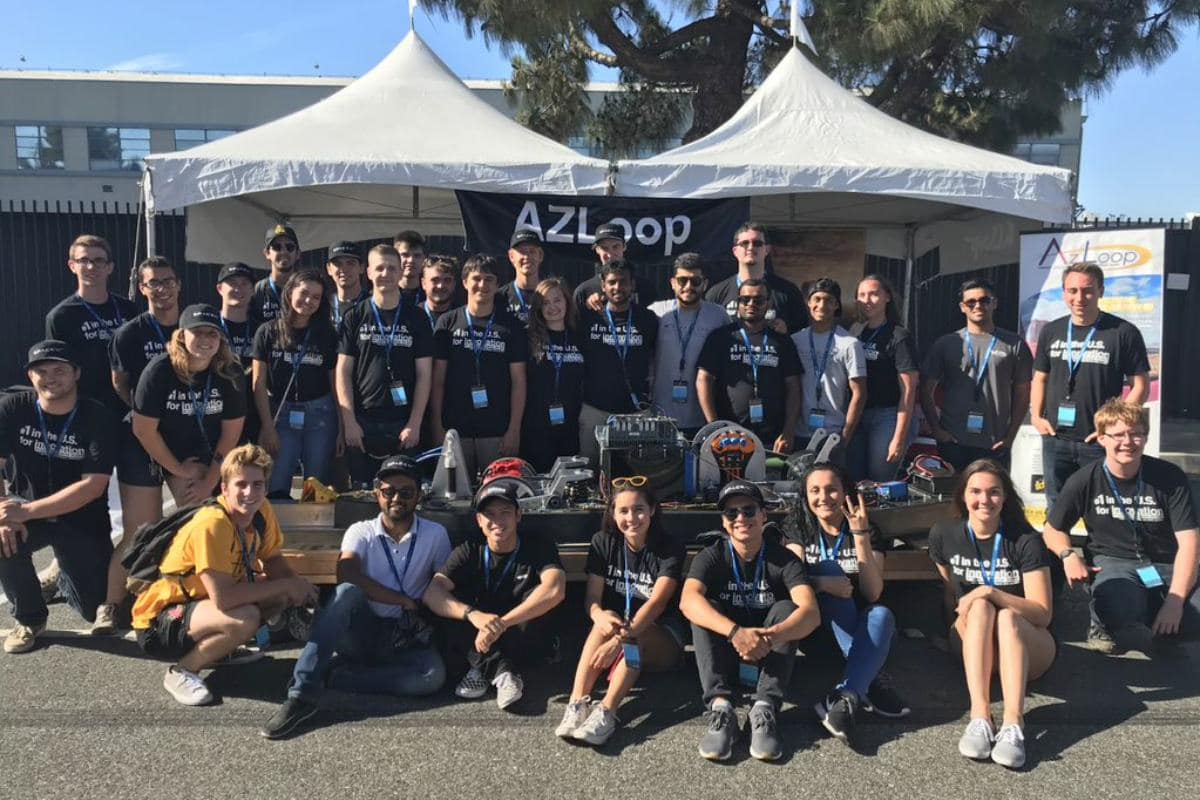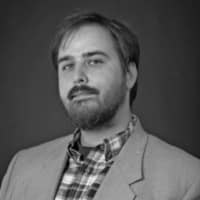Embry-Riddle Prescott Competes in SpaceX Hyperloop Competition

For a second year, Embry-Riddle Aeronautical University and Arizona State University students joined forces as the Arizona Hyperloop Team (“AZLoop”) to develop new super-fast mass transportation technology, in response to a SpaceX challenge.
Gathered at SpaceX headquarters in Hawthorne, Ca., AZLoop was among the 19 teams selected from more than 1000 groups around the world to submit their proposed Hyperloop pod designs for consideration at the third-ever competition of its kind. The event, hosted by SpaceX and The Boeing Company from July 15-22, challenged student teams to a single design objective: to achieve maximum speed.
AZLoop is a unique collaborative endeavor between two of Arizona’s premier Universities: Embry-Riddle in Prescott, Ariz., and host campus Arizona State University. This year’s team consisted of approximately 60 graduate and undergraduate students—16 from Embry-Riddle—pursuing degrees in engineering, business and science. The team sought to build upon last year’s success by re-evaluating their design and challenging themselves to achieve a projected speed of 200 MPH.
“The largest difference in design of last year’s pod was the chassis,” said Braking Team Lead and Embry-Riddle Aerospace Engineering – Astronautical student Kevin Gray. “Previously, the pod was built out of structural aluminum. This year, the manufacturing team opted for a carbon fiber body, reducing the weight of the chassis from more than 400 pounds to a mere 40 pounds. Additionally, we switched from a compressed air propulsion system to a driven wheel.”
Only three teams would test-run their pod designs on SpaceX’s mile-long vacuum tube track. To do so, every aspect of the team’s pod had to be rigorously tested in order to demonstrate the utmost in safety and reliability, said Software Engineering Assistant Professor Samuel B. Siewert, Embry-Riddle’s faculty advisor to the project.
“The team worked throughout the academic year, sacrificing personal time, tirelessly turning theory into propulsion, braking, structure, software and controls, integrated into an impressive system ready for competition day testing,” Siewert said. “This work got them through the majority of SpaceX pre-track testing and gave them the chance to share their designs with universities from all over the world.”
This year’s winning team, WARR Hyperloop from Munich, assembled a pod that reached a top speed of 290 mph, according to the team’s website. Like AZLoop, all teams were open-source and available only to students. Each team was required to submit preliminary pod designs, a final design package and an in-depth safety briefing to SpaceX representatives for review. In return, teams were provided with individualized feedback on their pod design concepts.
“We were pleased that we were once again selected to attend testing week, but we did not qualify in time to be one of the three teams to run the final track,” Gray said. “We are confident that upon returning from competition, we can finish testing the pod and run a small scale test on the facilities owned by the team.”
According to SpaceX’s website, the goal of the Hyperloop Pod Competition is to accelerate the development of functional prototypes and encourage student innovation, thus revolutionizing terrestrial transportation through Hyperloop services. Gray joined AZLoop in order to see Hyperloop in action, and to play a part in its development.
“I personally joined because I want this technology to be functioning within my lifespan,” Gray said. “Additionally, the engineering challenge is too great an opportunity to pass up. I think every engineering student should have an opportunity to work in such a diverse team environment. The interdisciplinary nature of this project is representative of the industry. It takes all types of engineers working together to build air and spacecraft. Learning to communicate effectively between these teams while in undergraduate studies will, I am certain, reflect positively once I’m in the industry. It is exactly this type of exposure that is critical for personal and professional development.”
Siewert said: “They learned an amazing amount about real world engineering—I’m blown away by their engineering skills, the grit to never give up, and [the] team effort of this student group. It was my honor to attend the event and serve as one of the many advisors at ERAU and ASU for this team.”
Although a fourth Hyperloop competition has not been officially announced, Gray voiced his enthusiasm for returning to AZLoop once again in hopes that the group’s pod design may be selected as one of the three final teams to run a prototype on the SpaceX test track next year.
“During the competition, I had discussions with emerging leaders from the ASU side of operations and they all expressed interest in continuing our relationship,” Gray said. “A lot of work and dedication went into this year. I would find it hard to believe that our members are willing to step away from such an ambitious project.”
“The competition gave me a new respect for the project-manager level of professionals who coordinate the completion of multiple subteams,” Gray said. “We work for an interdisciplinary team, communicating between mechanical, electrical and aerospace engineers, physics majors, business students and everything in-between. We are working on cutting-edge technologies. It was really the work of those around me, like Maciek Czyz, who was the president of the Embry-Riddle club, and the team members that made this all happen. I was simply lucky enough to be able to attend.”
This year’s Embry-Riddle AZLoop student team included:
Shadman Alamgir, Aerospace Engineering (Astronautics) – Braking
Trey Brown, Aerospace Engineering (Aeronautics) – Stability & Dynamics
Monica Choiniere, Aerospace Engineering (Astronautics) – Braking
Maciek Czyz, Aerospace Engineering (Astronautics) – President
Steven Duhamel, Mechanical Engineering (Propulsion) – Braking
Akhil Gampala, Aerospace Engineering (Astronautics) – Braking
Kevin Gray, Aerospace Engineering (Astronautics) – Braking Team Lead
Luke Hein, Aerospace Engineering (Astronautics) – Stability & Dynamics
Nedah Ibrahim, Software Engineering and Simulation Science, Gaming & Animation (Cyber Security) – Controls
Tristan Minkoff, Aerospace Engineering (Astronautics) – Levitation Team Lead
Alan Izquierdo Ramirez, Mechanical Engineering (Robotics) – Controls
Kevin Pereira, Software Engineering – Controls
Matthieu Rada, Mechanical Engineering (Robotics) – Braking
Angel Rodriguez, Aerospace Engineering (Aeronautics) – Braking
Kale Shumard-Crippin, Aerospace Engineering (Astronautics) – Braking
Blake Tangora, Aerospace Engineering (Aeronautics) – Braking
For more information on last year’s competition and hyperloop technology, read last year’s AZHyperloop competition coverage.
ABOUT EMBRY-RIDDLE AERONAUTICAL UNIVERSITY
Embry-Riddle Aeronautical University is the world’s largest, oldest and most comprehensive institution specializing in aviation, aerospace, engineering and related degree programs. A fully accredited university, Embry-Riddle is also a major research center, seeking solutions to real-world problems in partnership with the aerospace industry, other universities and government agencies. A nonprofit, independent institution, Embry-Riddle offers more than 80 baccalaureate, master’s and Ph.D. degree programs in its colleges of Arts & Sciences, Aviation, Business, Engineering and Security & Intelligence. The university educates students at residential campuses in Daytona Beach, Fla., and Prescott, Ariz., through its Worldwide Campus with more than 125 locations in the United States, Europe, Asia and the Middle East, and through online programs. For more information, visit www.embryriddle.edu, follow us on Twitter (@EmbryRiddle) and facebook.com/EmbryRiddleUniversity, and find expert videos at YouTube.com/EmbryRiddleUniv.

 Keaton S. Ziem
Keaton S. Ziem